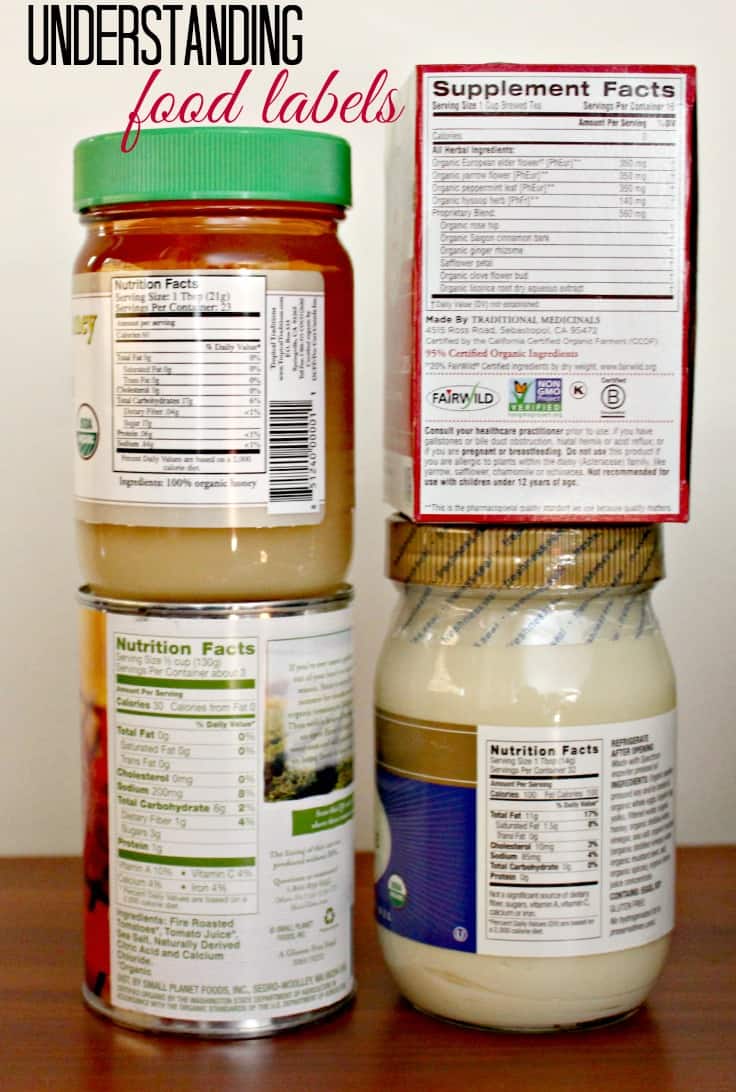Last Updated on September 13, 2020 by Ellen Christian
Understanding food labels can seem a bit like reading an ancient language sometimes. I’m one of those people who always reads the label. I want to know what’s in it, where it comes from and what effect it will have on my health goals. To do that, understanding food labels is the first step.
Posts may be sponsored. This post contains affiliate links, which means I will make a commission at no extra cost to you should you click through and make a purchase. As an Amazon Associate I earn from qualifying purchases.
Understanding Food Labels
Food labels contain a lot of information so it’s helpful to look at individual sections first. Each section of the food label gives you different information. All the food labels should have the same information available to you in about the same place.
- Nutrition Facts – At the very top of the label you will see the number of servings in the container and what the serving size is. Many “single serving” packages of things like chips, candy and cookies actually contain two to three servings so you’re being tricked into eating what you think is one serving when it’s not.
- Calories – This section will contain not only the calories (per serving) but also the calories that come from fat.
- Nutrient Breakdown – The next section will show you how much of each nutrient is in a serving. Depending on the food, you’ll see Fat, Sodium, Cholesterol, Carbohydrates and Protein. Limit things like Fat, Sodium, Cholesterol and Carbohydrates for the healthiest food choices. You’ll also see information on the various vitamins as well as iron, calcium, etc.
- Percent Daily Values – At the bottom, as a footnote, you will see the percent of the daily values a serving of that product contains. So if it’s very high in fat, one serving may use up an entire day’s worth (or more) of recommended daily values.
- Ingredients – Your food label will also contain the ingredients list. Note that ingredients are listed from the largest to smallest. So, if you see high fructose corn syrup or sugar in the first few spots of your food label, that’s what the largest ingredient in the food item is.
- Organic, non-GMO – Spin the food product around and look for any other official markings like organic or non-GMO verified. Note that “natural” is not a phrase that is regulated and means very little, if anything. You may also see gluten free, dairy free, fair trade, wild caught, etc. on the label.
Understanding food labels is the first step in making healthier food choices. If you’re interested in making healthier food choices, United Health Care has a new website called We Dare You to make this easier (and more fun). Just take small steps to live a little bit healthier every day, whether that is by eating healthier, or practicing healthier activities. You can complete dares to be entered to win $25 Visa gift cards weekly and the chance to win the grand prize of a $400 Visa gift card.
Now that you’ve learned a bit more about understanding food labels from me, you can watch a video about the topic and enter to win.
This post has been sponsored.

Ellen is a busy mom of a 24-year-old son and 29-year-old daughter. She owns six blogs and is addicted to social media. She believes that it doesn’t have to be difficult to lead a healthy life. She shares simple healthy living tips to show busy women how to lead fulfilling lives. If you’d like to work together, email info@confessionsofanover-workedmom.com to chat.



I started having to look at labels a number of years ago, after my youngest was diagnosed with Celiac disease. Gluten can hide in so many places!
Gluten is another difficult one, Val. My daughter is gluten intolerant.
There are so many weird words and stuff on the side of the packages. You need to look them up in a dictionary it seems. Thanks for all the cool information in one place.
I can totally understand that feeling, Aubrey!
It is so important to read the labels carefully! My son has had to eliminate all dairy products from his diet, even trace amounts, and it seems like all I do in the grocery store is examine labels trying to find foods that will work for him.
That is definitely a challenge, Anne!
One other thing to look for is the how the percentages are calculated. Most are based on 2000 or 2500 calories a day. Sooo…if you’re eating less calories than that, your percentages are going to be higher. Great tips, though!
Very true, Greta. There is so much to think about when choosing!
I remember when I first realized what a food label does! I was in College, a freshman…even though that was a long time ago. I was still really surprised I had never noticed the food label before. What an eye opener! The first thing I always check is the list of ingredients.
Same here, Amber. You can learn so much!